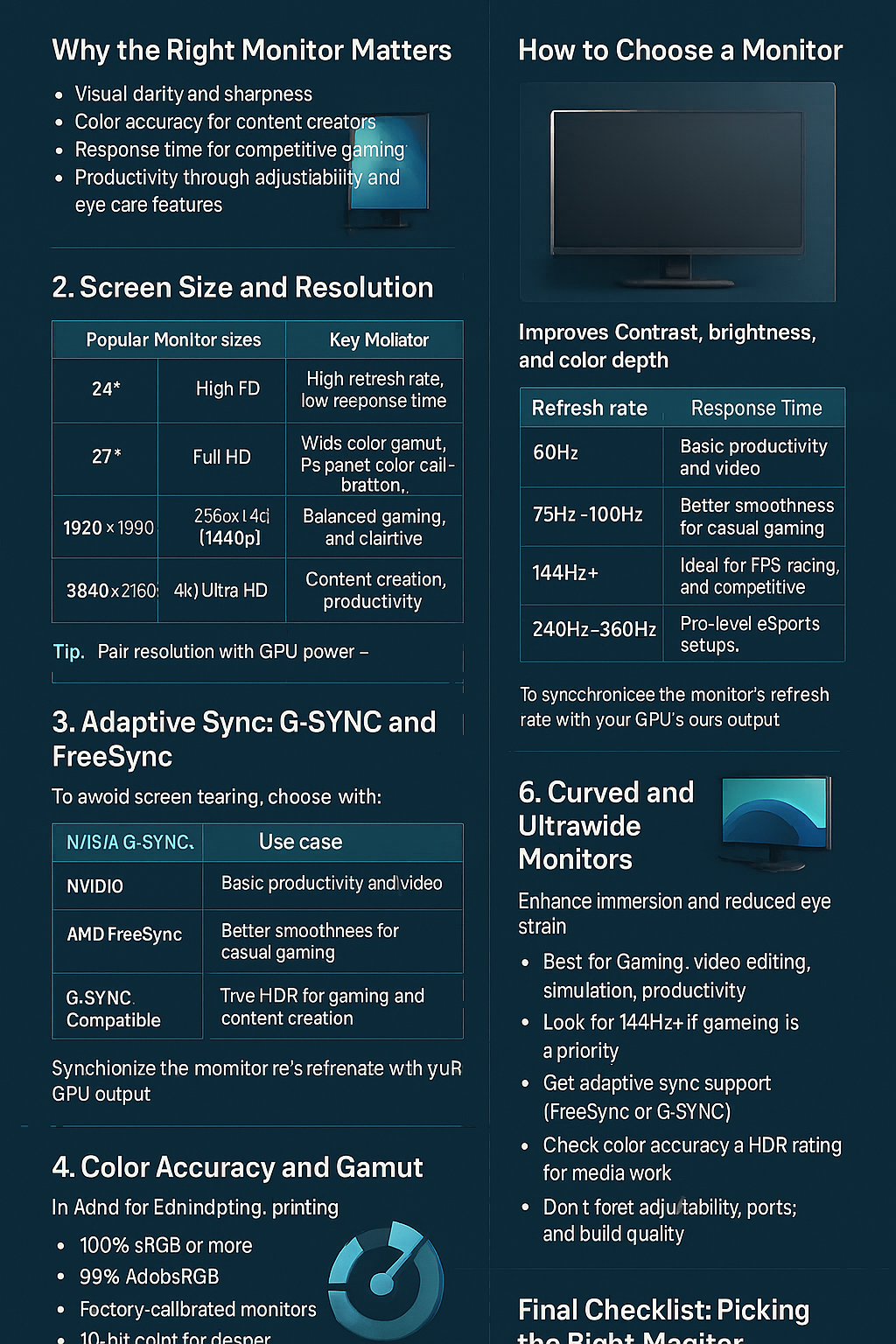A monitor is your primary interface with your computer. Whether you’re gaming, working, editing videos, or just browsing the web, your monitor dramatically affects your experience.
In 2025, the market offers more choices than ever — from high-refresh-rate displays to ultra-high-resolution and curved panels. This guide will help you choose the right monitor based on your needs, hardware, and budget.
Why the Right Monitor Matters
A great monitor improves:
- Visual clarity and sharpness
- Color accuracy for content creators
- Response time for competitive gaming
- Productivity through screen size and layout
- Ergonomics through adjustability and eye care features
Spending smart on your display ensures your powerful PC is fully appreciated.
1. Define Your Primary Use Case
| Use Case | Key Monitor Features |
|---|---|
| Gaming | High refresh rate, low response time, VRR support |
| Photo/Video Editing | Wide color gamut, IPS panel, color calibration |
| General Office Work | 24–27”, 1080p or higher, anti-glare, eye comfort |
| Programming/Multitasking | Ultrawide or dual setup, high resolution |
| Watching Movies/Streaming | IPS or VA panel, deep contrast, 4K or ultrawide |
2. Screen Size and Resolution
Popular Monitor Sizes:
- 24” – Compact, ideal for office setups
- 27” – Sweet spot for 1440p gaming and productivity
- 32”+ – Best for 4K or multitasking
- Ultrawide (34”–49”) – Immersive, replaces dual-monitor setups
Common Resolutions:
| Resolution | Pixels | Best For |
|---|---|---|
| 1920×1080 (1080p) | Full HD | Budget builds, casual gaming |
| 2560×1440 (1440p) | Quad HD | Balanced gaming and clarity |
| 3840×2160 (4K) | Ultra HD | Content creation, productivity |
| 3440×1440+ | Ultrawide | Immersion, multitasking |
Tip: Pair resolution with GPU power — 4K needs a strong graphics card.
3. Panel Types: IPS vs VA vs TN
| Panel Type | Pros | Cons |
|---|---|---|
| IPS | Best color, wide viewing angles | Higher price, lower contrast |
| VA | Great contrast, deep blacks | Slightly slower response time |
| TN | Fastest response, cheapest | Poor color and viewing angles |
Best for:
- Gaming: IPS or TN with high refresh rate
- Editing: IPS with 100% sRGB or AdobeRGB
- Movies: VA for deeper blacks
4. Refresh Rate and Response Time
- 60Hz: Basic productivity and video
- 75Hz–100Hz: Better smoothness for casual gaming
- 144Hz+: Ideal for FPS, racing, and competitive games
- 240Hz–360Hz: Pro-level eSports setups
Response time under 5ms is fine; 1ms is preferred for gaming.
5. Adaptive Sync: G-SYNC and FreeSync
To avoid screen tearing, choose a monitor with:
- NVIDIA G-SYNC (best for NVIDIA GPUs)
- AMD FreeSync (works on most modern GPUs)
- G-SYNC Compatible (validated FreeSync monitors)
These technologies synchronize the monitor’s refresh rate with your GPU’s output.
6. HDR: Is It Worth It?
HDR (High Dynamic Range) improves contrast, brightness, and color depth.
But not all HDR monitors are equal.
| HDR Standard | Brightness | Use Case |
|---|---|---|
| HDR10 | ~300–400 nits | Basic media HDR support |
| DisplayHDR 400/600/1000 | 400–1000+ nits | True HDR for gaming and content creation |
If a monitor advertises HDR but has low brightness, the effect may be minimal.
7. Color Accuracy and Gamut
For editing, printing, or video work, look for:
- 100% sRGB or more
- 99% AdobeRGB
- Factory-calibrated monitors
- 10-bit color for deeper gradients (vs standard 8-bit)
8. Curved and Ultrawide Monitors
Curved monitors enhance immersion and reduce eye strain.
- Best for: Gaming, video editing, simulation, productivity
- Look for: 1500R or 1800R curvature
- Ultrawide tip: Not all games support ultrawide natively
9. Ergonomics and Connectivity
Check for:
- Height, tilt, swivel, and pivot adjustment
- VESA mount support for monitor arms
- Ports: HDMI, DisplayPort, USB-C, audio out
Some modern monitors now offer KVM switch, USB hubs, and even charging through USB-C.
10. Recommended Monitor Brands in 2025
- LG – Excellent IPS panels and ultrawides
- Dell – Great office and editing monitors (UltraSharp series)
- ASUS – High-performance gaming displays (ROG, TUF)
- Samsung – Curved and QLED displays
- Gigabyte/AORUS – Value gaming monitors
- BenQ – Photo editing and eye comfort
- MSI – Gaming-focused curved panels
Final Checklist: Picking the Right Monitor
✅ Match screen size and resolution to your space and GPU
✅ Choose panel type based on your use case (IPS for color, TN for speed)
✅ Look for 144Hz+ if gaming is a priority
✅ Get adaptive sync support (FreeSync or G-SYNC)
✅ Check color accuracy and HDR rating for media work
✅ Don’t forget adjustability, ports, and build quality
A good monitor complements your powerful PC and maximizes its potential. In 2025, your display should be more than functional — it should enhance your entire computing experience.
